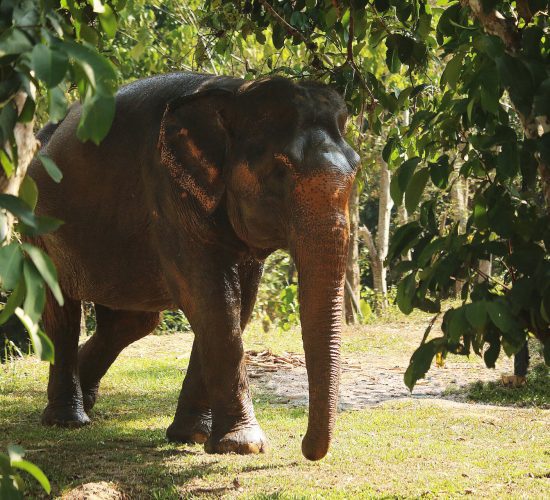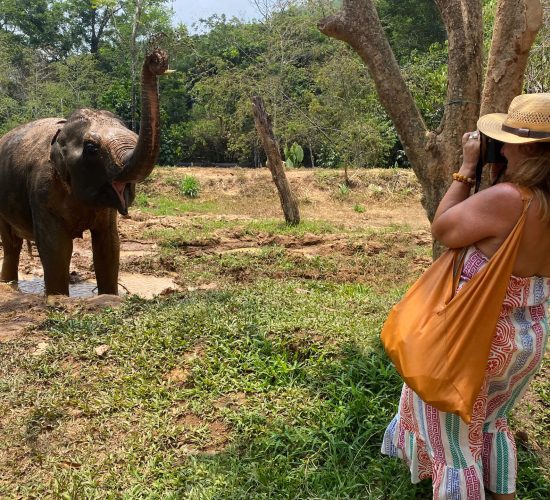Welcome to your complete guide to Phuket’s elephants!
We are Phuket Elephant Nature Reserve, an ethical, sustainable, and accredited elephant sanctuary in Phuket, Thailand.
Elephant conservation is at the heart of everything we do.
The welfare of our beautiful rescued elephants is our priority — and always will be.
Our ethical elephant activities in Phuket allow locals and tourists alike to enjoy experiences with a clear conscience.
We’ve used our years of knowledge and expertise to put together this guide so that everyone can share the passion we have for these gentle giants.
So scroll down to find out more about Phuket’s elephants! If you have any questions for us in the meantime, please get in touch.
When you step into the enchanting world of Phuket Elephant Nature Reserve, you’ll soon realise that everything we do promotes the health, safety, and well-being of Thailand’s most beloved creatures – Thai elephants!
These magnificent animals have woven themselves deeply into the fabric of Thai culture and history.
So prepare to explore the wonders of Thai elephants and the vital role they play in our tropical paradise.
And to discover more about us, check out our Guide to Phuket’s Most Ethical Elephant Sanctuary.

The elephants found in Phuket and across Thailand are Indian elephants, scientifically known as Elephas maximus indicus.
In turn, Indian elephants are a subspecies of the Asian elephant, along with Elephas maximus maximus (from Sri Lanka) and Elephas maximus sumatranus (from Sumatra).
Thai elephants share characteristics with other Indian and Asian elephants, such as their expressive trunks and impressive intelligence. But there are also notable differences, which we cover in the next section.
There are an estimated 3,000 to 4,000 elephants in Thailand, and approximately half are domesticated.
Our guide Why Does Thailand Have So Many Elephants? takes a deeper dive into this fascinating topic.
Thai elephants are characterized by their unique physical attributes. Compared to other Indian elephants, they’re smaller in stature, boasting shorter front legs and thicker bodies.
Their ears, often smaller than some people expect, remain essential in helping to regulate body temperature and expressing emotions.
These features collectively create an endearing appearance that sets them apart in the animal kingdom.
But what about the attributes that add up to make Thai elephants so large?
Of course, these figures are toward the maximum end of the scale. Our own elephants aren’t quite at these levels.
For comparison, Lotus weighs 2,500kg (2.5 tons), Bow weighs 3,500kg (3.5 tons), and Thonglor — the tallest of our elephants at 2.35 metres at the shoulder and weighs 3,200 kg (3.2 tons).
In Thailand, elephants are revered symbols of power, wisdom, and spiritual significance.
Throughout history, they’ve been integral to religious ceremonies, royal processions, and traditional festivities.
They also have strong links to transportation, the logging industry, and even ancient warfare.
Stretching back centuries, Thai people have revered elephants for their strength, durability, and longevity.
But these majestic creatures are also sacred due to their association with Buddhist beliefs. According to Buddhism, Buddha’s mother had a dream in which a white elephant gave her a lotus flower the night before he was born.
Because of this hallowed status, the elephant is a ubiquitous presence here in Thailand. You can truly find elephant imagery everywhere, from ornate temple decorations to beer bottles.
And the ultimate example of their cultural significance? An elephant stood at the centre of the Siamese flag until the early 20th century!
When Thai elephants roam their natural habitat, they exhibit fascinating behaviours that reflect their intelligence and social nature.
Within their close-knit groups, led by the matriarch, they communicate through a symphony of vocalisations, body language, and infrasound – creating a unique form of elephant conversation that never ceases to amaze.
It’s impossible to overstate the social aspect of an elephant’s nature. In the wild, they live in large “family” groups for their entire lives, never straying far from their mothers.
And in these groups, elephants love to roam. There are various studies on the topic of average walking distances, so the figures can vary.

However, just one example states an average of 1.9 to 7.5 miles a day in normal environmental conditions. In extreme conditions or during seasonal migrations, this can reach an average of 16.8 miles per day.
It’s clear, then, that being in most forms of captivity isn’t natural or healthy for elephants.
But it’s also important to note that domesticated elephants can’t survive in the wild and to make the distinction between being in captivity and being in a sanctuary.
To learn more about this, read our guide Is Being in Captivity Unhealthy for Elephants?
Thai elephants are herbivores with a healthy appetite for a variety of plant-based delights.
From lush grasses to flavourful fruits and even the occasional bark, their diet is as diverse as the habitats they call home.
A single elephant can consume between 150 to 170kg of food daily, which equates to around 5 to 10% of their total body weight. What’s more, eating this much food can take around 15 to 18 hours!
This not only shows that eating is a key part of an elephant’s day, but it’s also a stark reminder of the essential role they play in shaping ecosystems.
The importance of elephant conservation is as vital for the environment as it is for the animals themselves.
Our elephants have nutritional plans tailored to their needs. As rescued elephants, they each have their own stories of previous neglect that influence what they can and can’t eat today.
Lotus is a voracious eater and loves tucking into Napier grass, palm leaves, banana trees, and sugarcane (her favourite treat!). She also heads into the forest to find vines to munch on.
To balance her diet perfectly, we also feed her nutrient-rich rice balls.
Bow enjoys eating a variety of grasses and fruit. The latter includes bananas, pineapples, pumpkins, and watermelon.
To ensure she stays healthy, happy, and strong, we also give her nutritional pellets and a rice ball supplement mix.
And as for Thonglor — well, she only has three teeth left, so she finds it hard to eat hard foods like sugarcane and branches!
As a result, she tends to focus on soft grasses, bananas, and our homemade nutrient-rich rice balls.
Elephants in Thailand became endangered in 1986. This status has remained ever since.
The sharp decrease in numbers is due to various factors, but one of the biggest is habitat destruction. Thailand’s forests used to cover 90% of the country, but that has dwindled to around 30%.
An unwavering commitment to elephant conservation is the foundation on which we built Phuket Elephant Nature Reserve.
With a focus on rescue and rehabilitation, our sanctuary strives to provide elephants rescued from cruelty and neglect with the opportunity to rediscover a life of peace and happiness.
This is why our ethical elephant activities in Phuket focus on observation and education — but more on that below!
Our animal-first approach allows us to play our part in protecting these awe-inspiring creatures for generations to come.
Meet our elephants and see how rewarding conversation efforts can be.
The Thai elephant’s natural habitat is primarily tropical broadleaf forest, but they also roam in dry forests and on grassland.
These environments are rich in biodiversity, providing all the sustenance they need.
As such, while you can find them in pockets across the country, the largest numbers of wild Thai elephants are in the forests of northern and western Thailand. Their range also spills over into neighbouring countries like Myanmar and Laos.
Some of the places with large wild elephant populations are Khao Yai National Park (northeast of Bangkok), Mae Hong Son Province (northwest Thailand), Erawan National Park, and Huai Kha and Thung Yai Wildlife Sanctuaries (all in western Thailand).
In an age where responsible tourism is paramount, Phuket Elephant Nature Reserve stands as a beacon of ethical elephant experiences and activities.
Our approach revolves around observation, education, and admiration from a respectful distance.
We believe in providing elephants with the freedom to express their natural behaviours, unhindered by riding, bathing, and unnecessary touching.
This also means that you have a far more authentic experience, witnessing elephant behaviour as nature intended!
Read our previous guides Should I Ride Elephants in Thailand? and Why Bathing with Elephants is Unhygienic and Unethical to learn more about the importance of our passion for ethical elephant tourism.
We hope this guide to Phuket’s elephants has inspired you to visit our sanctuary and support ethical elephant tourism.
To start planning an unforgettable adventure with us, browse our range of Phuket elephant activities.
Do you have any questions for us? Please don’t hesitate to get in touch for all the answers you need.